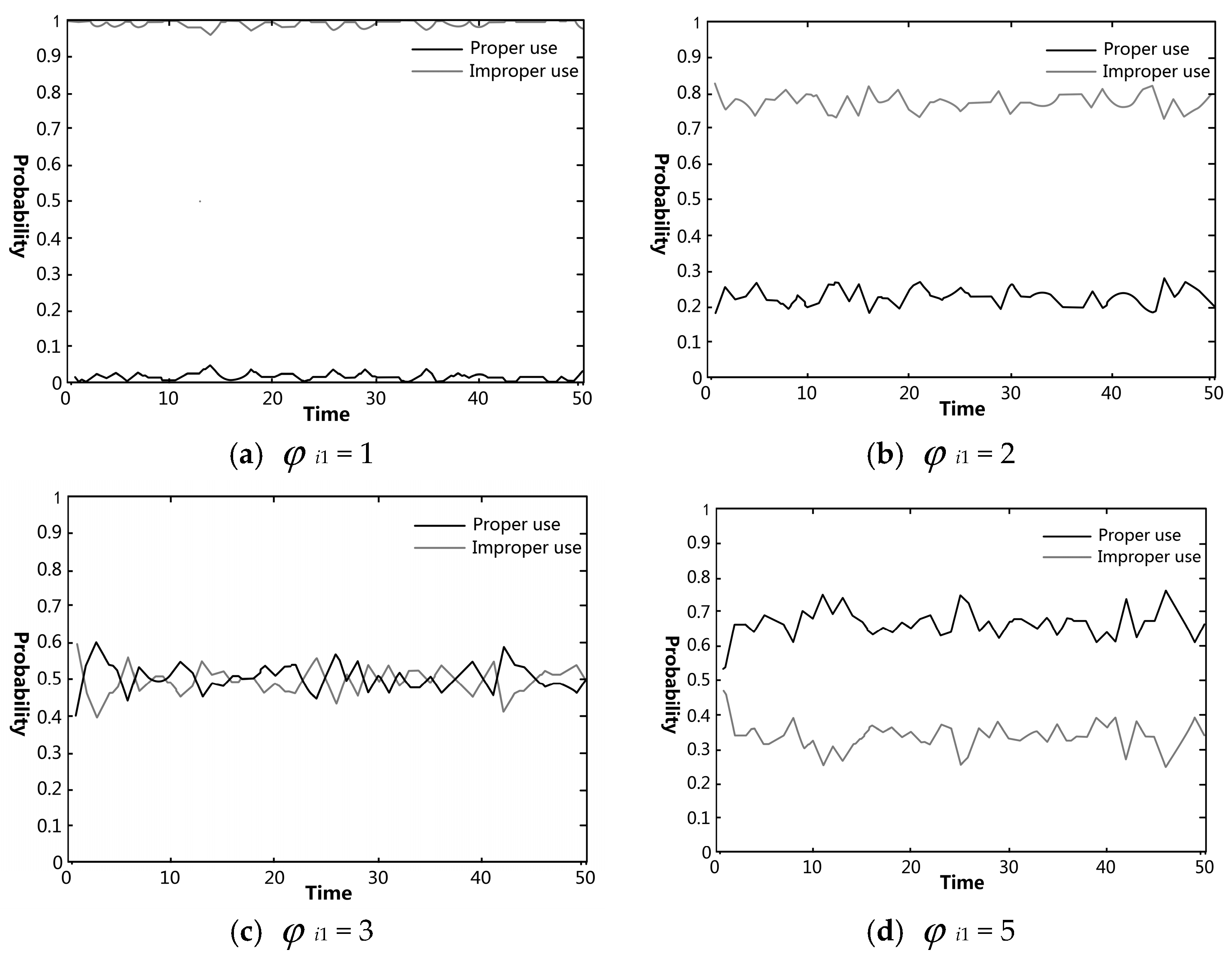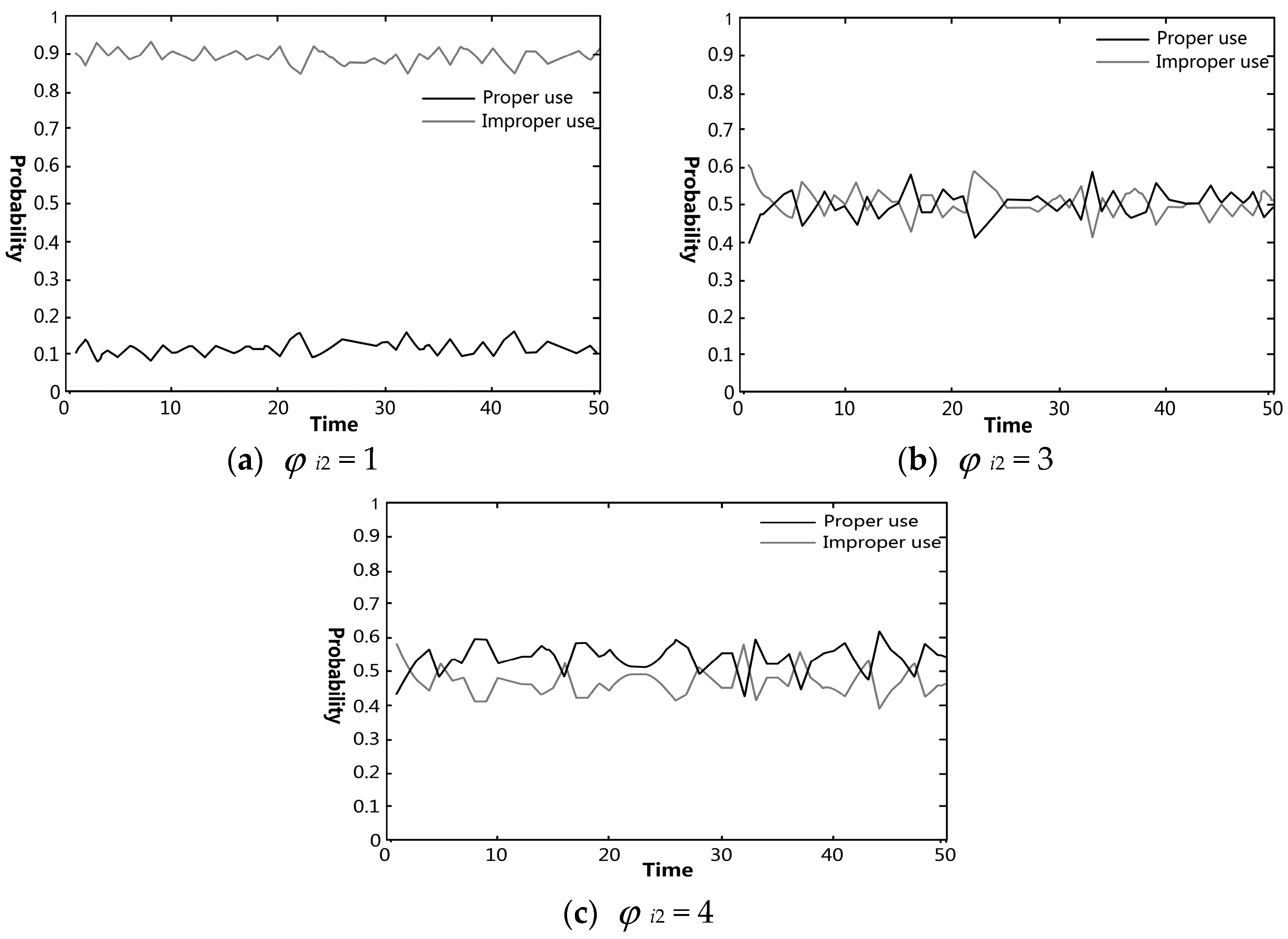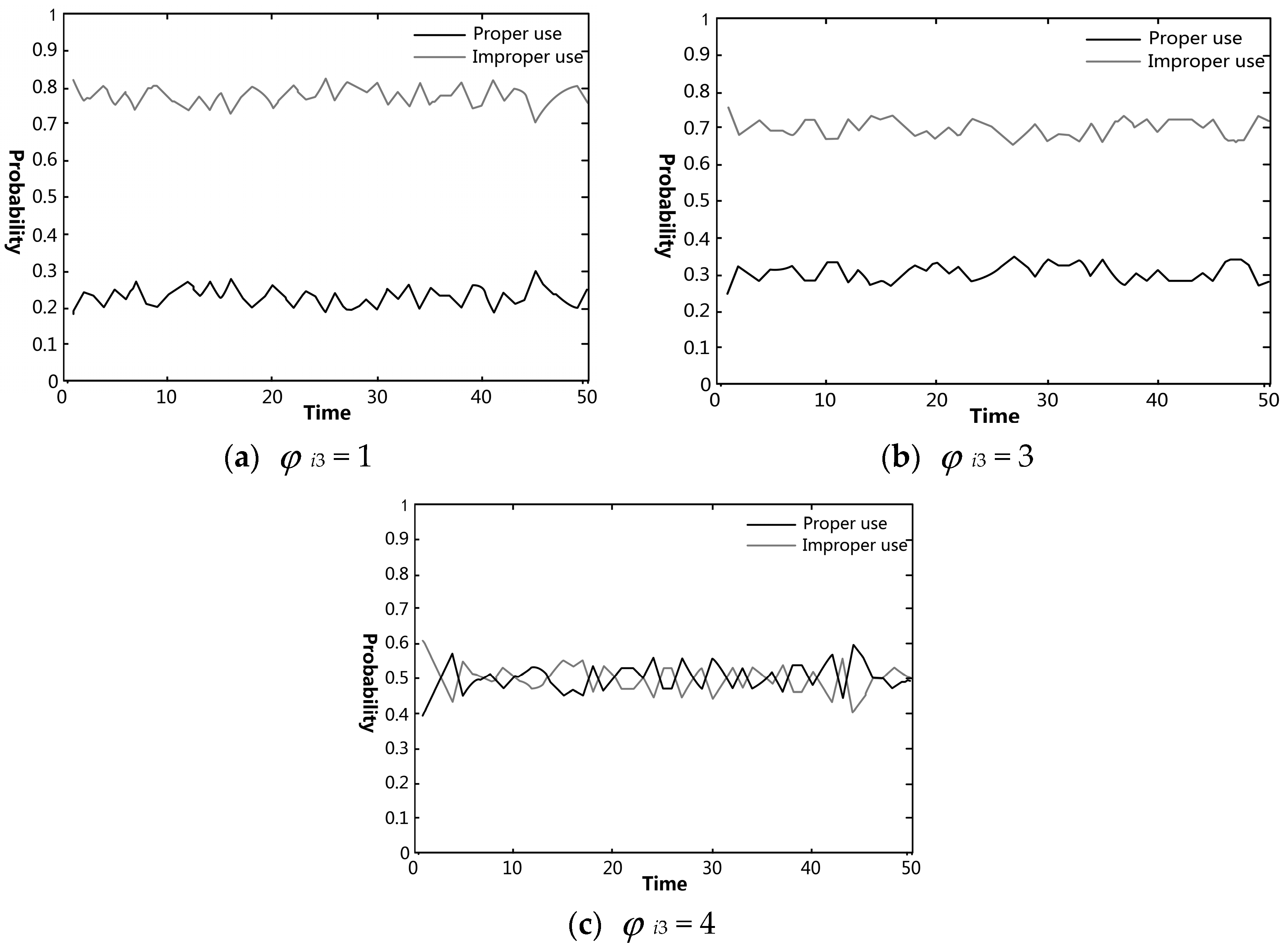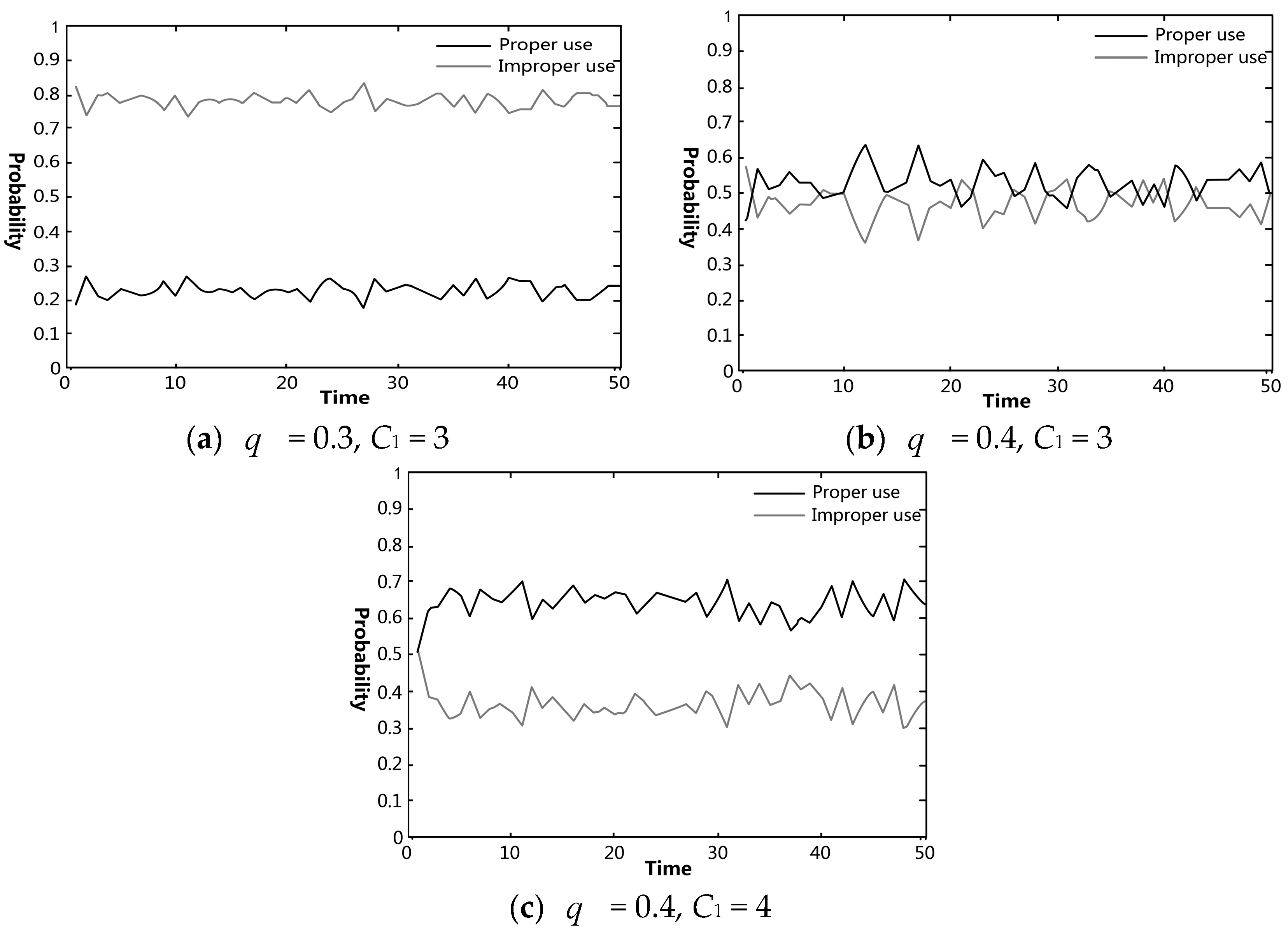Assessing the Linkages between Knowledge and Use of Veterinary Antibiotics by Pig Farmers in Rural China
Abstract
:1. Introduction
2. Materials and Methods
2.1. Sample Site
2.2. Study Design
2.3. Instruments
3. Model Approach and Simulation Scenarios
3.1. Model Construction for Farmers’ Behavior Choice
3.1.1. Basic Model Assumptions
- (1)
- There are only two choices—either proper or improper—for pig farmers regarding the use of VAs. Proper use refers to the use of VAs in a correct and reasonable way according to requirements. Improper use comprises of one or more behavior of VA overdose, use of human antibiotics, and non-compliance with withdrawal time requirements.
- (2)
- Pig farmers are economically rational. Their use of VAs follows the cost–benefit approach.
- (3)
- The government makes spot checks of farmers’ VA use during pig farming. Farmers will be subject to financial penalties, pressure of public opinion, and moral pressure, if improper use is discovered.
- (4)
- Pig farmers’ choice regarding VA use is a dynamic process affected by the behaviors of peers in real-world situations.
3.1.2. Farmers’ Knowledge
3.1.3. Farmers’ Expected Returns
3.1.4. Behavior Probability Model
3.2. Simulation Experiment Description
- (1)
- The simulation area is a 20 × 20 square area. At the start of the simulation, 100 farmers were randomly distributed in this area. Specific parameters are listed in Table 1 below.
- (2)
- Vision values of farmers. Farmers’ VA use is closely related to the behavior of their peers [25]. “Vision value” was used to indicate the ability of farmers to collect surrounding information in the model. The larger the value, the higher the ability to collect surrounding information. At the start of the simulation, 100 vision values were randomly generated and assigned to each farmer. A vision value of two means that a farmer can observe the behaviors of other farmers in 2 × 4 grids surrounding them. It was assumed that: (a) If a farmer’s behavior is A, and the number of A within their range of vision ≥ the number of B, they will maintain their own behavior; otherwise, their behavior will change to B; and (b) if a farmer’s behavior is B, they will maintain their own behavior if the number of B within their range of vision ≥ the number of A; otherwise, their behavior will change to A.
- (3)
- Knowledge of farmers. As set forth, φi1 (the farmers’ knowledge of VA use specification), φi2 (knowledge of hazards of VA residues), and φi3 (knowledge of relevant laws and their penalties), take a value in [1,5] in the simulation, respectively, where 1 means no knowledge and 5 means complete knowledge. Based on the behavior probability model, φi1, φi1, and φi3 are the coefficient part of proper use, and φi4, φi5, and φi6 are the coefficient part of improper use. As proper and improper VA uses are two opposite behaviors, when a farmer has a high willingness to perform one behavior, the willingness to perform the other behavior will be relatively low. Therefore, it is assumed that the relationship between the two sets of coefficients is as follows:To ensure scientific rigor and practical relevance of the simulation, the 100 farmers were assumed to have a lower-middle level of knowledge at the start of the simulation. It was assumed that φi0 = 2 and φi1 = φi2 = φi3 = 3, that is, the farmers’ three categories of knowledge fluctuated in the range of [1,3].
- (4)
- Farmers’ expected return. The farmers’ expected return can be calculated by Equations (1) and (2). Farmers’ normal return, G, follows uniform distribution in [5,9] (in ten thousand yuan). θ is the ratio of farmers’ increased return from improper VA use to that from proper usage. In general, the higher the knowledge level regarding VA use specification, the lower the probability of an improper return. Therefore, θ is correlated with φi1. To ensure that θ is nonnegative, it was assumed that θ + φi1 = 5. Based on the finding of field interview regarding spot checks for pig farmers that were conducted by government regulators each year, the initial value of q was set to 0.3. According to the Regulations on Administration of Veterinary Drugs in China, the penalty for improper VA use was set to 30,000 yuan considering the various forms of improper use. Hence, C1 = 3. The higher the farming return, the higher the pressure from public opinion and moral pressure when the misconduct is disclosed and sanctioned. Hence, it is assumed that C2 = 2 × G.
4. Results and Discussion
4.1. Sample Characteristics
4.2. Behaviors and Knowledge of Farmers Regarding Veterinary Antibiotics (VAs) Use
4.3. Simulation Experiment Results
4.3.1. Influence of Knowledge about VA Use Specification on Farmer’s Behavioral Choices
4.3.2. Influence of Knowledge about the Hazards of VA Residues on Farmer’s Behavioral Choices
4.3.3. Influence of Knowledge about the Relevant Laws and Their Penalties on Farmer’s Behavioral Choices
4.4. Influence of Government Regulation on Farmer’s Behavioral Choices
5. Conclusions and Policy Implications
Author Contributions
Funding
Acknowledgments
Conflicts of Interest
References
- Yang, Q.; Zhang, H.; Guo, Y.; Tian, T. Influence of Chicken Manure Fertilization on Antibiotic-Resistant Bacteria in Soil and the Endophytic Bacteria of Pakchoi. Int. J. Environ. Res. Public Health 2016, 13, 662. [Google Scholar] [CrossRef] [PubMed]
- Van Boeckel, T.P.; Brower, C.; Gilbert, M.; Grenfell, B.T.; Levin, S.A.; Robinson, T.P.; Teillant, A.; Laxminarayan, R. Global trends in antimicrobial use in food animals. Proc. Natl. Acad. Sci. USA 2015, 112, 5649–5654. [Google Scholar] [CrossRef] [PubMed]
- Center for Veterinary Medicine. CVM Updates—FDA Annual Summary Report on Antimicrobials Sold or Distributed in 2015 for Use in Food-Producing Animals. Available online: https://www.fda.gov/AnimalVeterinary/NewsEvents/CVMUpdates/ucm534244.htm (accessed on 30 May 2018).
- Sarmah, A.K.; Meyer, M.T.; Boxall, A.B.A. A global perspective on the use, sales, exposure pathways, occurrence, fate and effects of veterinary antibiotics (VAs) in the environment. Chemosphere 2006, 65, 725–759. [Google Scholar] [CrossRef] [PubMed]
- Ghosh, S.; LaPara, T.M. The Effects of Subtherapeutic Antibiotic Use in Farm Animals on the Proliferation and Persistence of Antibiotic Resistance among Soil Bacteria. ISME J. 2007, 1, 191–203. [Google Scholar] [CrossRef] [PubMed]
- Capita, R.; Alonso-Calleja, C. Antibiotic-Resistant Bacteria: A Challenge for the Food Industry. Crit. Rev. Food Sci. 2013, 53, 11–48. [Google Scholar] [CrossRef] [PubMed]
- Kummerer, K. Drugs in the Environment: Emission of Drugs Diagnostic Aids and Disinfectants into Wastewater by Hospitals in Relation to Other Sources—A Review. Chemosphere 2001, 45, 957–969. [Google Scholar] [CrossRef]
- Pan, M.; Wong, C.K.C.; Chu, L.M. Distribution of antibiotics in wastewater-irrigated soils and their accumulation in vegetable crops in the Pearl River Delta southern China. J. Agric. Food Chem. 2014, 62, 11062–11069. [Google Scholar] [CrossRef] [PubMed]
- Fahrion, A.S.; Jamir, L.; Richa, K.; Begum, S.; Rutsa, V.; Ao, S.; Padmakumar, V.P.; Deka, R.P.; Grace, D. Food-Safety Hazards in the Pork Chain in Nagaland, North East India: Implications for Human Health. Int. J. Environ. Res. Public Health 2014, 11, 403–417. [Google Scholar] [CrossRef] [PubMed]
- Neu, H.C. The crisis in antibiotic resistance. Science 1992, 257, 1064–1073. [Google Scholar] [CrossRef] [PubMed]
- Ying, G.; He, L.; Ying, A.; Zhang, Q.; Liu, Y.; Zhao, J. China Must Reduce Its Antibiotic Use. Environ. Sci. Technol. 2017, 51, 1072–1073. [Google Scholar] [CrossRef] [PubMed]
- Wilson, C. Battling resistance to antibiotics and pesticides: An economic approach. Ecol. Econ. 2004, 50, 159–160. [Google Scholar] [CrossRef]
- Hvistendahl, M. China takes aim at rampant antibiotic resistance. Science 2012, 336, 795. [Google Scholar] [CrossRef] [PubMed]
- Chen, X.; Wu, L.; Xie, X.; Zhu, D.; Wang, J.; Zhang, X. Influence of pig farmer characteristics on improper use of veterinary drugs. Trop. Anim. Health Prod. 2016, 48, 1395–1400. [Google Scholar] [CrossRef] [PubMed]
- Zhang, Q.Q.; Ying, G.G.; Pan, C.G.; Liu, Y.S.; Zhao, J.L. Comprehensive evaluation of antibiotics emission andfate in the river basins of China: Source analysis, multimedia modeling, and linkage to bacterial resistance. Environ. Sci. Technol. 2015, 49, 6772–6782. [Google Scholar] [CrossRef] [PubMed]
- Gao, L.; Tan, Y.; Zhang, X.; Hu, J.; Miao, Z.; Wei, L.; Chai, T. Emissions of Escherichia coli Carrying Extended-Spectrum β-Lactamase Resistance from Pig Farms to the Surrounding Environment. Int. J. Environ. Res. Public Health 2015, 12, 4203–4213. [Google Scholar] [CrossRef] [PubMed]
- Lee, C.-R.; Cho, I.H.; Jeong, B.C.; Lee, S.H. Strategies to Minimize Antibiotic Resistance. Int. J. Environ. Res. Public Health 2013, 10, 4274–4305. [Google Scholar] [CrossRef] [PubMed]
- Walder, P.; Kantelhardt, K. The Environmental Behaviour of Farmers—Capturing the Diversity of Perspectives with a Q Methodological Approach. Ecol. Econ. 2018, 143, 55–63. [Google Scholar] [CrossRef]
- Visschers, V.H.M.; Iten, D.M.; Riklin, A.; Hartmann, S.; Sidler, X.; Siegrist, M. Swiss pig farmers’ perception and usage of antibiotics during the fattening period. Livest. Sci. 2014, 162, 223–232. [Google Scholar] [CrossRef]
- Huang, J.H. Survey of the Status of Veterinary Use in Pig Farming. Heilongjiang Anim. Sci. Vet. Med. 2010, 9, 117–119. [Google Scholar]
- Kuipers, A.; Koops, W.J.; Wemmenhove, H. Antibiotic use in dairy herds in the Netherlands from 2005 to 2012. J. Dairy Sci. 2016, 99, 1632–1648. [Google Scholar] [CrossRef] [PubMed]
- Wu, L.; Xu, G.; Li, Q.; Hou, B.; Hu, W.; Wang, J. Investigation of the disposal of dead pigs by pig farmersin mainland China by simulation experiment. Environ. Sci. Pollut. Res. 2017, 24, 1469–1483. [Google Scholar] [CrossRef] [PubMed]
- Sun, S.; Jiao, Y.; Liu, C. The Mathematical Model of Behavior Probability. Syst. Eng. Theory Pract. 2007, 27, 79–86. [Google Scholar] [CrossRef]
- Zhou, R.; Yu, D.; Tu, G. System Model and Simulation for Diffusion of Agricultural Technology based on Farmer Knowledge Behavior. J. Syst. Manag. 2017, 26, 701–712. [Google Scholar]
- Chen, Y.; Fang, R. An Empirical Analysis of Influence Factors of Farmers’ Behavior of Admindtering Fishery Drugs. Chin. Rural Econ. 2011, 8, 72–80. [Google Scholar]
- Wu, X.; Mao, Y.; Zhan, S.; Yu, X.; Zhang, Y. Behavior of Pig Farmers to Use Veterinary Drugs and Antibiotic Analysis Based on Questionnaire Investigation into 964 Pig Farmers. Chin. J. Anim. Sci. 2013, 49, 19–23. [Google Scholar]
- Pham, D.K.; Chu, J.; Do, N.T.; Brose, F.; Degand, G.; Delahaut, P.; De Pauw, E.; Douny, C.; Van Nguyen, K.; Vu, T.D.; et al. Monitoring antibiotic use and residue in freshwater aquaculture for domestic use in Vietnam. EcoHealth 2015, 12, 480–489. [Google Scholar] [CrossRef] [PubMed]
- Poizat, A.; Bonnet-Beaugrand, F.; Rault, A.; Fourichon, C.; Bareille, N. Antibiotic use by farmers to control mastitis as influenced by health advice and dairy farming systems. Prev. Vet. Med. 2017, 146, 61–72. [Google Scholar] [CrossRef] [PubMed]
- Chen, B.; Zheng, Q. Study on Influence Factors on Intention of Pollution-Free Products Supply and Empirical Research. World Agric. 2010, 2, 21–25. [Google Scholar]
- Garforth, C.J.; Bailey, A.P.; Tranter, R.B. Farmers’attitudes to diseaserisk management in England: A comparative analysis of sheep andpig farmers. Prev. Vet. Med. 2013, 110, 456–466. [Google Scholar] [CrossRef] [PubMed]





| Model Parameters | Parameter Value (Symbol) |
|---|---|
| Area | 20 × 20 |
| Total number of farmers, N | 100 |
| Farmers: proper use | A |
| Farmers: improper use | B |
| Vacancy | O |
| Characteristics | Categories | Frequency (n) | Percentage (%) |
|---|---|---|---|
| Gender | Male | 387 | 59.2 |
| Female | 267 | 40.8 | |
| Education Attainment | Primary school and lower | 384 | 58.7 |
| Middle school | 186 | 28.4 | |
| High School and Above | 84 | 12.9 | |
| Number of household members | 1 | 12 | 1.8 |
| 2 | 57 | 8.7 | |
| 3 | 93 | 14.2 | |
| 4 | 156 | 23.9 | |
| 5 or more | 336 | 51.4 | |
| Proportion of pig production to family income | 30% or less | 432 | 66.1 |
| 31–50% | 78 | 11.9 | |
| 51–80% | 54 | 8.3 | |
| 81–90% | 33 | 5.0 | |
| 91% or more | 57 | 8.7 | |
| Years of farming | 1–3 years | 45 | 6.9 |
| 4–6 years | 42 | 6.4 | |
| 7–10 years | 51 | 7.8 | |
| Over 10 years | 516 | 78.9 | |
| Slaughter amount | 1–30 pigs | 417 | 63.8 |
| 31–100 pigs | 135 | 20.6 | |
| Over 100 pigs | 102 | 15.6 |
| Knowledge | 1 = No Knowledge | 2 = Little Knowledge | 3 = Moderate Knowledge | 4 = Good Knowledge | 5 = Complete Knowledge |
|---|---|---|---|---|---|
| VAs should be used as directed by a veterinarian in strict accordance with the manufacturer’s instructions | 78.03 | 19.27 | 0.30 | 1.22 | 1.22 |
| Antibiotics customized for human cannot be used in pig farming | 66.21 | 22.48 | 1.22 | 7.34 | 2.75 |
| VA residues can cause antibiotic resistance and endanger human health | 48.17 | 28.90 | 7.80 | 12.84 | 2.29 |
| Farmers will be punished by the government for improper VA use | 64.68 | 22.02 | 3.67 | 8.26 | 1.37 |
© 2018 by the authors. Licensee MDPI, Basel, Switzerland. This article is an open access article distributed under the terms and conditions of the Creative Commons Attribution (CC BY) license (http://creativecommons.org/licenses/by/4.0/).
Share and Cite
Chen, X.; Wu, L.; Xie, X. Assessing the Linkages between Knowledge and Use of Veterinary Antibiotics by Pig Farmers in Rural China. Int. J. Environ. Res. Public Health 2018, 15, 1126. https://0-doi-org.brum.beds.ac.uk/10.3390/ijerph15061126
Chen X, Wu L, Xie X. Assessing the Linkages between Knowledge and Use of Veterinary Antibiotics by Pig Farmers in Rural China. International Journal of Environmental Research and Public Health. 2018; 15(6):1126. https://0-doi-org.brum.beds.ac.uk/10.3390/ijerph15061126
Chicago/Turabian StyleChen, Xiujuan, Linhai Wu, and Xuyan Xie. 2018. "Assessing the Linkages between Knowledge and Use of Veterinary Antibiotics by Pig Farmers in Rural China" International Journal of Environmental Research and Public Health 15, no. 6: 1126. https://0-doi-org.brum.beds.ac.uk/10.3390/ijerph15061126





